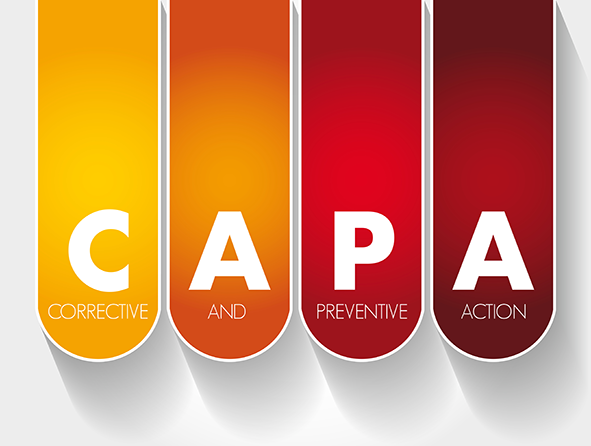What is prophylaxis?
When the author gave a presentation on CAPA at a webinar on May 25, the most frequently asked question was about “preventive measures.
In CAPA, the order of response to a given unfavorable event is “first aid,” “correction,” “corrective action,” and “preventive action,” in that order.
As an example, consider a fatal accident caused by a drunk driver.
First aid: Treat the injured.
Correction: Put up safety signs to prevent secondary disasters from occurring.
Corrective action: Revoke the license of the driver in question. (Prevention of recurrence)
Preventive action: Establish the crime of dangerous driving manslaughter. (Punish other actions that result in tragic deaths and injuries similar to drunk driving accidents.)
(Note: In international standards, etc., “first aid” is included in “correction” and is not distinguished.)
Many companies in Japan misunderstand CAPA.
(See our article “Misconceptions of CAPA“).
The CAPA consists of seven steps.
(See our article “7 Stages of CAPA“).
Preventive measures are risk management.
Incidentally, ISO 9001:2015 has eliminated the “preventive action” bullet point.
The reason for this is that the definition of “preventive action” is as follows
“Action to eliminate the cause of any possible nonconformity or other possible undesirable situation.”
Here, a possible nonconformity refers to a problem that has not yet occurred, i.e., a risk. In other words, “preventive action” refers to “risk management.
(See our article “About Preventive Action Being Risk Management“).
Precautionary measures” are a must.
When “Corrective Action” is implemented, “Preventive Action” is mandatory.
In ISO 9001:2008 and ISO 13485, there is a distinction between “corrective action” and “preventive action. This is to distinguish between “corrective action” and “preventive action” when the certification body conducts an audit and issues a finding.
However, FDA regulatory requirements and other regulations do not distinguish between “corrective and preventive action” as in “Corrective and Preventive Action”.
Basically, if “corrective action” is implemented, “preventive action” is mandatory.
Until now, FDA inspections have focused on “corrective actions,” but in the future, the agency intends to emphasize “preventive actions,” or risk management.
What is “prophylaxis?”
So what exactly is “prophylactic treatment”?
When the author conducts consultations and seminars, he says, “Horizontal development is not preventive action. It is a corrective action. This is not a preventive measure.
(See our article, “Why Horizontal Expansion Is Not a Preventive Measure “).
So what exactly is “prophylactic treatment”?
Preventive action” refers to risk management, which basically means to properly identify risks (problems that have not yet occurred) in the relevant process or product and control the risks before they occur. In other words, while “corrective action” is in the past tense (prevention of recurrence of problems that have occurred), “preventive action” is in the future tense (prevention of problems that have not yet occurred).
Let me show you an example.
【Example 1】Preventive measures” using statistical methods
The refrigerator temperature was set at 5°C. (Refrigeration: 2°C to 8°C)
Suppose that when the chamber temperature is measured over time, it is 6°C the next day and 7°C the day after that.
In turn, if left unchecked, the temperature will eventually exceed 8°C and deviate.
In this case, the root cause of the temperature increase (called the latent cause in “preventive measures”) is to be investigated as well as the temperature adjustment is to be performed again.
For example, there could be many possible causes, such as aging of the refrigerator, door sealing problems, frequent opening and closing of the door, and long periods of time the door is open.
In this case, since the temperature deviation has not yet occurred, it is a “preventive action” rather than a “corrective action.
【Example 2】Crush other root causes that have the same grave consequences
As noted in the opening example of a fatal accident caused by a drunk driver, the equivalent of preventive action would be to punish other conduct that results in a tragic fatality or injury similar to that caused by a drunk driver.
In other words, it is the investigation of events that have the same outcome but different root causes.
For example, in addition to drunk driving, other causes of tragic fatalities and injuries may include smoking illegal drugs (dangerous drugs) while driving, distracted driving, driving while extremely tired, and driving while elderly or with a serious medical condition.
Investigating and preventing other root causes that may cause the same result as a problem that has already occurred is one type of “preventive action,” while applying the same root cause to other products or processes (horizontal deployment) is “corrective action,” not “preventive action.
【Notice】
A video of the author’s 5/25 presentation (also available by clicking on the banner below) and seminar materials (PowerPoint) will be provided free of charge.
If you would like to apply, please send an e-mail to
support@ecompliance
related product
[blogcard url=https://xn--2lwu4a.jp/qms-alex/ title=”QMS(手順書)ひな形 医薬品関連” ]]]>


Comment